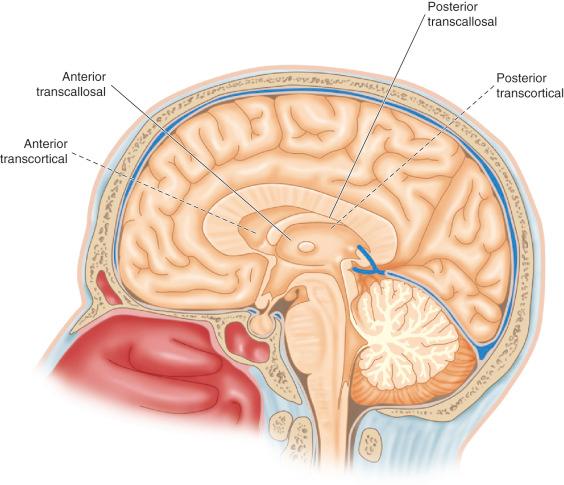Physical Address
304 North Cardinal St.
Dorchester Center, MA 02124
Tumors of the lateral ventricle represent less than 1% of all intracranial tumors. The majority of these lesions are benign or low grade.
The lateral ventricles are amongst the most challenging areas to operate in the brain and require special approaches to facilitate maneuverability.
The principal approaches to the lateral and third ventricles include ( Figure 13.1 ):
The transcortical approach:
Anterior transcortical.
Posterior transcortical.
Transtemporal.
The transcallosal, interhemispheric approach.

Microscopic vs. endoscopic: Endoscopic approaches are best suited for simple biopsy, endoscopic third ventriculostomy, cyst fenestration and resection of lesions not exceeding 2–3 cm in size and that are not very vascular.
Transcortical vs. transcallosal: Both approaches are usually effective and safe. Maneuverability through the tight transcallosal corridor, which is limited by the pericallosal arteries, may be more challenging but can be the procedure of choice if ventricles are not enlarged.
Type of lesion, surrounding neural structures, anatomic landmarks, size of the ventricles and surgeon's comfort will determine the selected approach.
Single or combined transcortical approaches allow access to all five regions of the lateral ventricles: anterior horn, body, temporal horn, atrium and occipital horn.
Once the lateral ventricle has been entered, the third ventricle can be approached via a:
Subchoroidal approach (trans-velum interpositum).
Transforaminal approach.
Lesions that can be approached through a transcortical approach include: colloid cysts, choroid plexus tumors, gliomas, central neurocytomas and meningiomas located in the atrium or in the trigone.
Patients with enlarged ventricles: the transcortical dissection will be less traumatic and the maneuverability is increased. This approach can also be a good alternative to the transcallosal approach for some deep-seated tumors of the lateral ventricles that extend to the third ventricle. It avoids sectioning of the anterior corpus callosum and manipulation of the fornix while providing superior working space in the lateral ventricles.
The perirolandic transcortical approach is contraindicated for tumors of the midventricular body. It increases the risk of motor or sensory cortex damage when approaching that region.
Accessing a lesion through the dominant hemisphere may be contraindicated. Large lesions of the dominant hemisphere that extend to the contralateral ventricle may be approached through the contralateral non-dominant hemisphere.
Although non-dilated ventricles used to be a contraindication, current technical and diagnostic advances make this approach feasible. The outcome remains skill-dependent.
MRI with and without gadolinium helps determine the characteristics of the lesion and selection of an appropriate surgical approach.
MRA and angiography are useful for identifying feeding vessels and venous return. Although it is technically challenging, embolization of the vasculature may be accomplished during the angiography, facilitating excision of the lesion and minimizing blood loss that can obscure the surgical field during the procedure.
Brain mapping is a useful tool to avoid damage to the eloquent areas when selecting the cortical area to transect.
A ventriculoperitoneal (VP) shunt or ventriculostomy may be placed in patients presenting with acute severe hydrocephalus. This is especially useful in infants with CSF-producing tumors (e.g. choroid plexus papillomas). A VP shunt may allow the patient to grow until surgery is feasible.
In this section, descriptions of the transcortical approaches to the ventricle through the anterior transcortical, posterior transcortical and transtemporal routes are presented ( Figure 13.1 ). Entrance into the ventricle and lesion management are described later in this chapter and are valid for the three routes once the surgeon has arrived at the ventricle.
Preferred for lesions located in the anterior horn with or without extension to the third ventricle.
The approach is ideally performed in the non-dominant hemisphere.
Become a Clinical Tree membership for Full access and enjoy Unlimited articles
If you are a member. Log in here